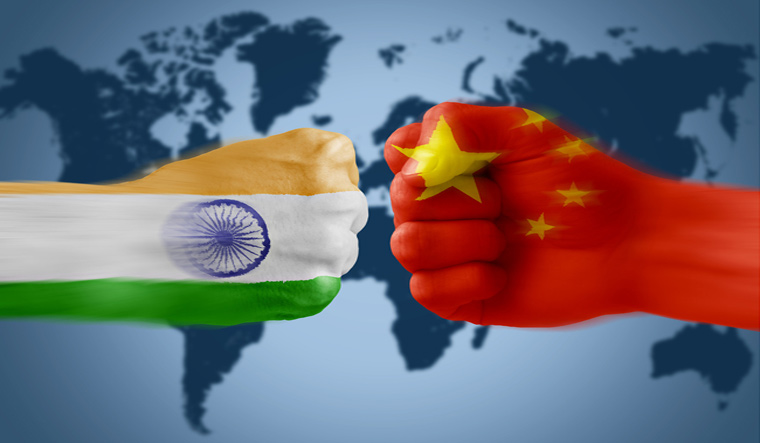As tensions simmer at the border between India and China, what is more concerning is the economic fall out of the souring relationship between the two countries. This is because the economic interdependence of the two neighbours is too deep to be ignored.
China and the US are the largest two trading partners of India. While Indian exports to the US outnumber the imports from the country, the same is not true when it comes to China. And hence, to become friends-turned-foes with India would have business repercussions in China, too.
India’s top trading partner
For the period between April 2019 and February this year, China accounted for 11.8 per cent of India’s total imports. However, India’s total exports to the country was a mere 3 per cent. Clearly, we buy more from China than we sell. This trade deficit with China, also a major contributor to India's overall trade deficit, is one of the world's biggest trade deficits between two nations
The deficit with China stood at $3.3 billion in February, a 13 per cent rise from the year-ago period. This is even as India’s overall trade deficit remained flat from a year ago at $9.8 billion.
However, bilateral trade has reduced drastically over the past two months due to both the pandemic and the rising cold vibes between the nations. Earlier, on Tuesday, the Confederation of All India Traders (CAIT) released a list of 500 categories of products imported from China that it said could be swapped with goods made in India. CAIT wants to bring down the imports from China to $13 billion by December 2021 from $70 billion in 2018-19. It said it plans to do so by substituting a list of goods imported from China with local goods.
What India imports from China?
India's imports from China rose from 13.7 per cent in 20-18-19 to 14.1 per cent in 2019-20. India's major imports from the neighbour include engineering goods, electronics, pharmaceuticals and automobile components. At a total value of over $18 billion, electronic imports formed a quarter of the total imports in February.
Nuclear reactors, machinery and parts comprised another major chunk of the imports at $12 billion.
What India exports to China?
India's exports to China rose from 5.1 per cent in 2018-19 to 5.3 per cent in 2019-20 (until February). Organic chemical, ores, slag and ash, and mineral oils, mineral fuels and other industry products comprise India's exports to the country.
Despite the total value of India’s exports growing by nearly half between 2010 and 2019, the sum going to China shrank 14 per cent over the period, deepening a trade deficit that’s fueling India’s nationalistic turn.
Chinese FDI to India
As per a Brookings India report, the total amount of current and planned Chinese investment in India has crossed $26 billion (around Rs 1,98,000 crore). China-based companies are also stepping up their investments in Indian companies, including startups, the report said.
The numbers clearly show India's heavily reliance on Chinese imports and any disruption of trade ties between the two countries will substantially hurt Indian businesses.
It is no secret that India is the biggest market for Chinese businesses outside their own country. Citing Gateway House research, CNN reported that Chinese investors have poured some $4 billion into Indian tech startups since 2015.
Alibaba, for example, has invested in Indian e-commerce company Snapdeal, digital wallet Paytm and food delivery platform Zomato. Tencent, meanwhile, has backed Indian messaging company Hike and ride hailing app Ola. Gateway House found that more than half of India's 30 unicorns—private firms worth more than $1 billion—have Chinese investors.
Meanwhile, India changed its FDI policy in April soon after the People's Bank of China decided to up its stake in India's HDFC bank to over 1 per cent. As per the tweak, neighbouring nations can invest in Indian firms only after getting the Centre's approval for the same.
China retaliated saying India's new policy violated WTO's principle of non-discrimination and are against the general trend of free trade.
And Huawei is still in the running to help build 5G networks in India's fast-growing internet economy, despite a US-led campaign against the Chinese company. The Indian government has already started mulling amending the latest telecom tenders to cause a body blow to Huawei. According to various reports, more such measures will follow.
China’s Xiaomi leads the India smartphone market with 30 per cent market share, followed by Vivo, Samsung, Realme and Oppo.
To be sure, several large Chinese companies spanning handsets, electronic devices and internet firms are deeply invested in India’s consumer market where a fast growing middle-class and an aspirational young consumer base has helped propel the growth for companies such as Xiaomi Corp, BBK Electronics that owns brands such as Oppo, Vivo, among others; apart from electronics goods company TCL. India's emergence as the biggest overseas market for Chinese mobile phone companies is one of the most significant developments in China's relations with India over the past five years. The India sales of those top Chinese smartphone brands totaled more than $16 billion in 2019, according to IDC.
The Chinese smartphone makers have already built factories and created jobs in India. Interestingly, these smartphone makers have embraced Prime Minister Narendra Modi's "Make in India" programme. Xiaomi locally manufactures 95 per cent of the phones it sells in India. And hence, any adverse announcements forcing Chinese businesses to shut shop in India will add to the burgeoning unemployment rates in India.
While it is widely perceived that India might be most impacted economically in case of a conflict with China, the latter, too, will lose a significant and perhaps, one of the most easily accessible markets. Hence, China will stand as much to lose as India.


